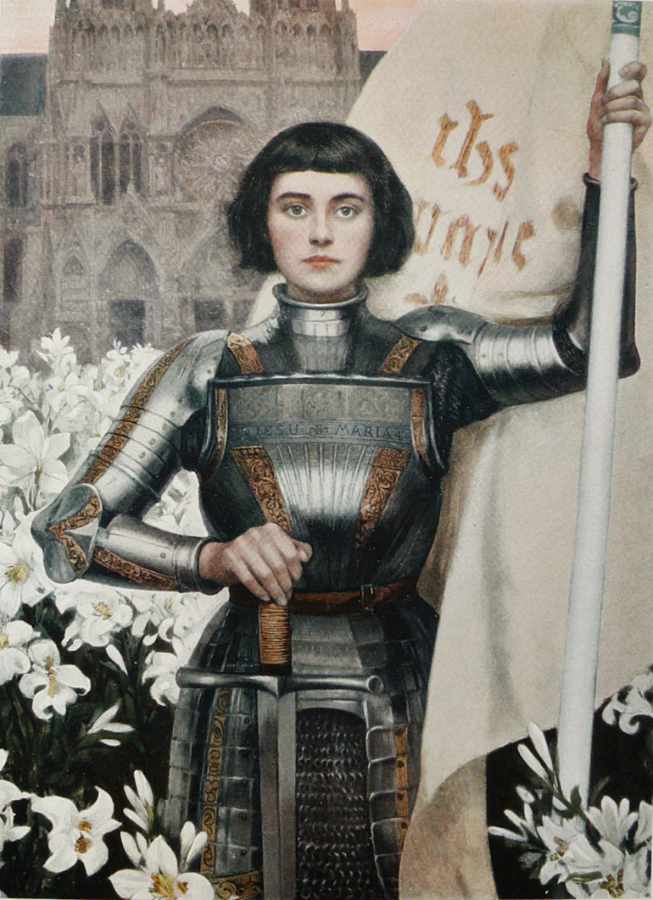Joan of Arc (French: Jeanne d’Arc; c. 1412 – 30 May 1431) is a patron saint of France, honored as a defender of the French nation for her role in the siege of Orléans and her insistence on the coronation of Charles VII of France during the Hundred Years’ War. Stating that she was acting under divine guidance, she became a military leader who transcended gender roles and gained recognition as a savior of France. Joan was born to a propertied peasant family at Domrémy in northeast France. In 1428, she requested to be taken to Charles, later testifying that she was guided by visions from the archangel Michael, Saint Margaret, and Saint Catherine to help him save France from English domination. Convinced of her devotion and purity, Charles sent Joan, who was about seventeen years old, to the siege of Orléans as part of a relief army. She arrived at the city in April 1429, wielding her banner and bringing hope to the demoralized French army. Nine days after her arrival, the English abandoned the siege. Joan encouraged the French to aggressively pursue the English during the Loire Campaign, which culminated in another decisive victory at Patay, opening the way for the French army to advance on Reims unopposed, where Charles was crowned as the King of France with Joan at his side. These victories boosted French morale, paving the way for their final triumph in the Hundred Years’ War several decades later. After Charles’s coronation, Joan participated in the unsuccessful siege of Paris in September 1429 and the failed siege of La Charité in November. Her role in these defeats reduced the court’s faith in her. In early 1430, Joan organized a company of volunteers to relieve Compiègne, which had been besieged by the Burgundians—French allies of the English. She was captured by Burgundian troops on 23 May. After trying unsuccessfully to escape, she was handed to the English in November. She was put on trial by Bishop Pierre Cauchon on accusations of heresy, which included blaspheming by wearing men’s clothes, acting upon visions that were demonic, and refusing to submit her words and deeds to the judgment of the church. She was declared guilty and burned at the stake on 30 May 1431, aged about nineteen. In 1456, an inquisitorial court reinvestigated Joan’s trial and overturned the verdict, declaring that it was tainted by deceit and procedural errors. Joan has been revered as a martyr, and viewed as an obedient daughter of the Roman Catholic Church, an early feminist, and a symbol of freedom and independence. After the French Revolution, she became a national symbol of France. In 1920, Joan of Arc was canonized by the Roman Catholic Church and, two years later, was declared one of the patron saints of France.
| Alias Joan of Arc |
| Real Names/Alt Names |
| Characteristics Historical Figures, Paranormal Mysteries, Medieval Age |
| Creators/Key Contributors ○ |
| First Appearance Historical figure (b. 1412 – d. 1431) |
| First Publisher ○ |
| Appearance List Literature: Joan of Arc – the Maid of Orleans – From Mitchelet’s History of France (1855), Personal Recollections of Joan of Arc by Mark Twain (1896), Jeanne D’Arc, Maid of Orleans, Deliverer of France, Being the Story of Her Life, Her Achievements, and Her Death, As Attested on Oath and Set Forth in the Original Documents (1902), The Maid of France – Being the Story of the Life and Death of Jeanne d’Arc by Andrew Lang (1909), The Story of Mankind by Hendrik Willem van Loon (1921), The Trial of Jeanne d’Arc (1932), Saint Joan of Arc (1936), The Retrial of Joan of Arc; The Evidence at the Trial For Her Rehabilitation 1450–1456 (1955), The Judgements of Joan – A Study in Cultural History (1961), The First Biography of Joan of Arc with the Chronicle Record of a Contemporary Account (1964). Theater: Over 400 plays and musical works by 1894, including Henry VI Part 1 by William Shakespeare (1590), Friedrich Schiller’s The Maid of Orleans (1801 play) and Verdi’s and Tchaikovsky’s operatic adaptations, Saint Joan by George Bernard Shaw (1923), Saint Joan of the Stockyards by Bertolt Brecht (1930). Film: 26 films before 1965 including George Méliès’ Jeanne d’Arc (1900) and Carl Theodor Dreyer’s The Passion of Joan of Arc (1928). |
| Sample Read Personal Recollections of Joan of Arc by Mark Twain (1896) [Internet Archive] |
| Description Joan of Arc (French: Jeanne d’Arc; c. 1412 – 30 May 1431) is a patron saint of France, honored as a defender of the French nation for her role in the siege of Orléans and her insistence on the coronation of Charles VII of France during the Hundred Years’ War. Stating that she was acting under divine guidance, she became a military leader who transcended gender roles and gained recognition as a savior of France. Joan was born to a propertied peasant family at Domrémy in northeast France. In 1428, she requested to be taken to Charles, later testifying that she was guided by visions from the archangel Michael, Saint Margaret, and Saint Catherine to help him save France from English domination. Convinced of her devotion and purity, Charles sent Joan, who was about seventeen years old, to the siege of Orléans as part of a relief army. She arrived at the city in April 1429, wielding her banner and bringing hope to the demoralized French army. Nine days after her arrival, the English abandoned the siege. Joan encouraged the French to aggressively pursue the English during the Loire Campaign, which culminated in another decisive victory at Patay, opening the way for the French army to advance on Reims unopposed, where Charles was crowned as the King of France with Joan at his side. These victories boosted French morale, paving the way for their final triumph in the Hundred Years’ War several decades later. After Charles’s coronation, Joan participated in the unsuccessful siege of Paris in September 1429 and the failed siege of La Charité in November. Her role in these defeats reduced the court’s faith in her. In early 1430, Joan organized a company of volunteers to relieve Compiègne, which had been besieged by the Burgundians—French allies of the English. She was captured by Burgundian troops on 23 May. After trying unsuccessfully to escape, she was handed to the English in November. She was put on trial by Bishop Pierre Cauchon on accusations of heresy, which included blaspheming by wearing men’s clothes, acting upon visions that were demonic, and refusing to submit her words and deeds to the judgment of the church. She was declared guilty and burned at the stake on 30 May 1431, aged about nineteen. In 1456, an inquisitorial court reinvestigated Joan’s trial and overturned the verdict, declaring that it was tainted by deceit and procedural errors. Joan has been revered as a martyr, and viewed as an obedient daughter of the Roman Catholic Church, an early feminist, and a symbol of freedom and independence. After the French Revolution, she became a national symbol of France. In 1920, Joan of Arc was canonized by the Roman Catholic Church and, two years later, was declared one of the patron saints of France. |
| Source Joan of Arc – Wikipedia |



